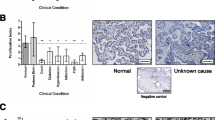Abstract
Objective
To describe the relationship between the degree of placental histologic villous mineralization (VM) and stillbirth in anueploid and euploid fetuses.
Methods
The extent of VM for aneuploid and gestational age-matched euploid placentas was graded semiquantitatively on a 0 to 3 scale based on the number of terminal or stem villi containing mineralizations in forty × 10 fields of view. The extent of VM was analyzed in relation to fetal status at delivery (liveborn or stillborn) for both aneuploid and euploid fetuses.
Results
For 14 available aneuploid placentas, grade 0 or 1 VM was recorded for seven aneuploid specimens, of which two were stillborn. Grade 2 or 3 VM was recorded for seven aneuploid specimens, of which six were stillborn. Fourteen gestational age-matched euploid placentas served as controls. Grade 0 or 1 VM was observed in nine euploid specimens, of which four were stillborn. Grade 2 or 3 VM was observed in five euploid specimens, of which four were stillborn. For aneuploid fetuses, stillbirth was significantly more frequent with grade 2 or 3 VM compared with grade 0 or 1 VM (χ2 = 4.667, P < .05). This relationship did not exist for euploid fetuses (χ2 = 1.659, P > .05).
Conclusion
Histologic VM is not a universal finding in, or exclusive to, stillbirths. Aneuploid but not euploid stillbirths show increased histologic VM compared with livebirths. This may implicate impaired placental or circulatory function as a mechanism for death in aneuploid fetuses.
Similar content being viewed by others
References
Frank HG, Kaufmann P. Nonvillous parts and trophoblast invasion. In: Benirschke K, Kaufmann P, eds. The pathology of the placenta. 4th ed. New York: Springer-Verlag, 2000:203–8.
Fox H. Calcification of the placenta. J Obstet Gynaecol Br Commonw 1964;71:759–64.
Avery CR, Aterman K. Calcification of the basement membrane of placental villi. J Pathol 1964;103:199–200.
Birkenfeld A, Mordel N, Okon E. Direct demonstration of iron in a term placenta in a case of beta-thalassemia major. Am J Obstet Gynecol 1989;160:562–3.
Krohn K, Ljungqvist A, Robertson B. Trophoblastic and sub-trophoblastic mineral salt deposition in hydramnios. Acta Pathol Microbiol Scand 1967;69:514–20.
Drachenberg CB, Papadimitriou JC. Placental iron deposits: Significance in normal and abnormal pregnancies. Hum Pathol 1994;25:379–85.
Benirschke K, Kaufmann P. Abortion, placentas of trisomies, and immunological considerations of recurrent reproductive failure. In: Benirschke K, Kaufmann P, eds. The pathology of the placenta. 4th ed. New York: Springer-Verlag, 2000:688.
Starzyk KA, Salafia CM, Pezzullo JC, et al. Quantitative differences in arterial morphometry define the placental bed in preeclampsia. Hum Pathol 1997;28:353–8.
McDermott M, Gillan JE. Trophoblast basement membrane haemosiderosis in the placental lesion of fetal artery thrombosis: A marker for disturbance of maternofetal transfer? Placenta 1995;16:171–8.
McMenamin ME, Ramalakshmi S, Kelehan P, O’Regan M, Gillan JE. Chorionic villous haemosiderin in hydrops fetalis and preeclampsia may assist in positively identifying fetoplacental failure (abstract). Placenta 1997;18:A39.
Sander CH. Hemorrhagic endovasculitis and hemorrhagic villitis of the placenta. Arch Pathol Lab Med 1980;104:371–3.
Shen-Schwarz S, Macpherson TA, Mueller-Heubach E. The clinical significance of hemorrhagic endovasculitis of the placenta. Am J Obstet Gynecol 1988;159:48–51.
Author information
Authors and Affiliations
Corresponding author
Additional information
The opinions and assertions contained herein are the private views of the authors and are not to be construed as official or reflecting the views of the Department of the Air Force, Department of the Army, or the Department of Defense.
Rights and permissions
About this article
Cite this article
Pierce, B.T., Martin, L.S., Hume, R.F. et al. Relationship Between the Extent of Histologic Villous Mineralization and Stillbirth in Aneuploid and Euploid Fetuses. Reprod. Sci. 9, 290–293 (2002). https://doi.org/10.1177/107155760200900506
Published:
Issue Date:
DOI: https://doi.org/10.1177/107155760200900506




